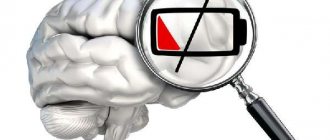Concept and meaning
Emotions are elementary experiences. They can occur under the influence of external or internal stimuli. The nature of the manifestation depends on the degree of satisfaction of one’s own desires and expectations.
Emotions play a huge role. Depends on your emotional state:
- career advancement;
- development of personal interests;
- communication with family;
- physical health.
If a person is depressed, health problems may begin and physical activity will decrease.
Don't let fears stop you from becoming a better person.
It often happens that one part of us really wants to change, and the other, consciously or unconsciously, suppresses these changes. This comes from the inherent desire in every person to suffer.
We believe that letting go of old fears and worries will make us betray ourselves. But that's not true. The only right decision will be a sincere desire to change and develop that part of your personality that will allow you to reveal your self.
Types and characteristics
Psychologists distinguish several types of manifestations - emotions, affects, feelings, moods, stress, frustration. Each of them has certain characteristics.
Emotions
Complex mental phenomena. The most significant are stress, feelings, moods. Emotions can be distinguished from affects by their duration. Affects are short-term manifestations. Emotions can change your mental state for a long time.
Affects
Affects are powerful manifestations of psychological reactions. They can be compared to emotional outbursts that change the mental state for a short period of time. Examples of affects:
- horror;
- rage;
- anger;
- deep grief;
- wild joy;
- despair.
When affects arise, they completely take over the psyche. Such outbursts completely suppress the will. Affects are irresistible; they force a person to take some action, which often has bad consequences.
Feelings
Feelings are emotional processes that last longer than affects, but are less intense. They can manifest themselves in relation to any object, animal, or other person. Feelings motivate a person to take any action.
Moods
Moods are emotional processes that last longer than affects. The intensity is extremely weak. Such manifestations include boredom, neutrality, indifference, dissatisfaction, satisfaction.
Stress
Stress is an emotional state that arises as a reaction to various events and extreme influences. They arise due to failures, losses, a series of difficult life moments, conflict situations, and trials.
Stress is familiar to people who are engaged in responsible work and develop a business. They are constantly nervous and tension builds up, causing a nervous breakdown.
One of the well-known emotional states that is similar to prolonged stress is emotional burnout.
Frustration
Frustration occurs when plans are systematically destroyed, upset, or deceived. More often caused by insurmountable difficulties, barriers, difficulties that arise when achieving a certain goal.
Frustration is accompanied by negative feelings. They are capable of destroying activity and consciousness. Kinds:
- external, internal aggression;
- depression;
- bitterness;
- grief;
- dissatisfaction.
Frustration intensifies if failures constantly arise in different areas of life, others reproach the person for this, blame, humiliate, criticize.
Classification of ISS
Types and types of methods through which it is possible to achieve ASC:
Trance
It occurs due to sensory deprivation, that is, partial or complete restriction of the flow of information coming from outside. For example, if a person is “turned off” from vision and hearing using a headband and headphones and left completely alone for several hours, he will go into a trance.
The brain will feel such a strong hunger, a lack of information from the outside, that by turning on the unconscious it will begin to supply it on its own.
Simply put, such a person will begin to remember events that were repressed many years ago, realize the root causes and motives of any actions, and so on.
Trance is also achieved through some rituals, usually they are mystical or religious in nature.
A person in a trance feels a certain detachment from what is happening in the world around him; what worried him before is of no interest at the moment. The intensity of feelings decreases so much that it seems as if he is incapable of anything other than indifference.
This occurs due to the narrowing of consciousness, it becomes tunnel-like. That is, it covers only the area that caused these changes.
When a person comes out of a trance, she may not remember what happened to her, this is something like amnesia. Sometimes somatic ailments are observed in the form of dizziness, nausea, weakness in the body, etc.
Achieved through the following methods:
Meditation
Meditation is a kind of “turning off” sensory systems and internal dialogue. A person is in the position of an observer, only attention is directed deep into himself.
Constant practice improves health, increases the level of awareness, develops various cognitive abilities, such as memory, the ability to concentrate for a long time on one activity, subject, and so on. You can learn more about the benefits of meditation from this article.
Hypnosis
During hypnosis, the individual loses the ability to think subjectively, make decisions and evaluate what is happening. He perceives everything that is suggested to him and becomes executory.
After the end of the session, he may also not remember what the conversation was about. But subconsciously he will begin to perform the actions that the specialist ordered to be done. Mainly used for medicinal purposes, for example, to overcome addiction to smoking, alcohol, and drugs.
Or to change your life by doing self-hypnosis and giving yourself instructions to be happy, successful, to stop being afraid... Often scammers use it for selfish purposes to take possession of other people’s property, instill the idea of committing a crime, and so on.
Dance
Even primitive civilizations used dance as a way to achieve ASC. Until now, many tribes turn to their gods with the help of chaotic movements. The monotony and monotony of the rhythm really puts you in a trance.
If you observe people who have completely given themselves over to dance, you will notice that they lose the ability to perceive the surrounding reality as before, as if they were somewhere very far away.
Coffin therapy
This shocking technology involves placing a person in a coffin and burying it. Shallowly, for a few hours. Sensory deprivation is certainly guaranteed.
Feeling buried, he stops worrying, for example, about an unfinished work project, that the neighbor has a better car and a more beautiful wife. Pressing problems begin to seem insignificant and so petty that after digging out he literally becomes a different person.
The minutes spent in a coffin underground evoke a strong desire to reconsider your value system. There comes an understanding of how much one wants to live, which is especially important for people who were planning to commit suicide on the basis of unrequited love, etc.
But this is all provided that the person managed to control himself and achieve ASC, otherwise none of the above will be achieved except a panic attack or a heart attack.
Extended States of Consciousness (ESC)
With RSS, the person is aware of what he feels, moreover, he controls the process and, if necessary, can stop it at any time. Achieved with:
Holotropic Breathwork
Czech psychiatrist Stanislav Grof studied the effects of LSD and psychoactive substances on the body and behavior of the individual as a whole.
But in 1960, LSD became a banned drug, as a result of which he had to look for new methods to achieve ASC. It was then that he came up with holotropic breathing.
The essence of this technique is deep and frequent breathing for a long time. About an hour and a half.
It is ideal to do this in a group format under the supervision of an instructor or specialist. But you can also try it at home, although it is quite dangerous. And now you will understand why.
There are two groups of experiences of the holotropic state:
Perinatal
The personality literally returns to the prenatal period and again experiences the sensations that it experienced at that time. Thanks to this, she has a chance to understand some of the root causes of her difficulties and limitations.
This gives a powerful psychotherapeutic effect. And who doesn’t want to once again be in bliss, weightlessness and carelessness? But some “return” at the time of childbirth, sometimes difficult and traumatic.
Accordingly, they experience “hellish torment,” gasping for breath as they move along the birth canal and being afraid that the uterus is squeezing and pushing them out. And if you experience something like this on your own, you can subsequently cause yourself more harm than good.
Transpersonal
Going beyond the body and, in general, your ego. At such a moment, you can access the memory of the family. That is, to information that has been accumulated by your ancestors for centuries, passed on from generation to generation.
Carl Jung called this state the collective unconscious. An individual is able to fully identify with other people, animals, plants and even processes.
Dream
During sleep, we not only rest and fill ourselves with energy, restore resources, but also process the information received during the day. Accordingly, our brain never stops working.
The dreams that visit us are called windows into parallel worlds. Since the control of consciousness weakens, accordingly, fantasy has no boundaries.
There are so-called lucid dreams. This is when a person understands that he is currently sleeping, and accordingly, he can do whatever he wants, interrupting his sleep if necessary. Reaching this level is only possible with the help of certain training.
Functions
Psychologists identify a number of functions that emotions perform:
- Mobilization. This function manifests itself at the physiological level. The main manifestations are the release of adrenaline into the blood, dulling of sensations, narrowing of consciousness. The described manifestations help to discard unnecessary thoughts and act according to a specific situation.
- Grade. With the help of emotions, you can instantly assess the current situation or external stimulus. The emotional assessment appears before a detailed answer is composed. The first impression of a new person is extremely difficult to destroy.
- Compensation. Emotions can be called the highest order of intelligence. They do not go against reason. Psychologists call them a resource for solving various problems. For example, with the help of positive emotions you can strengthen needs, and with the help of negative ones you can reduce their effectiveness.
- Trace formation. Situations often happen when emotions appear too late, when everything is over, nothing serious can be changed. The created emotional effect is fixed in memory and will arise when similar situations arise.
- Communication. Emotions have an expressive component. They are transparent to society. For example, when one person expresses pain, the bitterness of loss, those around them have an altruistic motivation, a desire to help. Often such manifestations lead to new acquaintances, which can play a significant role in life.
Content:
- Motivation for change - how to find the right one?
- How to change yourself beyond recognition internally - an action plan
- How to change yourself beyond recognition externally - basic concepts
Most sources, in response to the question of how to change yourself beyond recognition internally and externally for the better, will suggest that you go to the gym at best, but usually get plastic surgery.
We will start with what lies on the surface - namely, the reasons for dissatisfaction with oneself.
Application of the Abraham Hicks scale to assess the condition
To create an accurate psychological description of a person’s emotional states and identify disturbances in the emotional sphere, you can use the Abraham Hicks scale. It can be used to describe a wide range of feelings - from negative to positive. Feelings on the scale are divided by color.
It is important to remember the feature of the scale. It is impossible to move along the scale from one side to the other without passing through intermediate stages. For example, it is impossible to go from suffering immediately to joy. Colors go from red to purple. The neutral zone, which is located in the center, is indicated in green.
Red zone
Manifestations:
- hopelessness;
- impotence;
- depression;
- despair;
- uncertainty;
- bitterness;
- envy;
- misfortune;
- humiliation;
- fear;
- shame;
- abandonment.
To move through the negative zone, you need to experience negativity, try to express it in order to move towards positive emotions.
Orange
The orange zone is less negative, but the sensations remain bad:
- fright;
- detachment;
- indignation;
- undervalued;
- anger;
- revenge;
- guilt;
- mistrust;
- resentment;
- hatred;
- discouragement.
It is important to be patient when navigating the different zones of the scale. To get rid of negative feelings, you can use natural psychological defense mechanisms, for example, shifting the blame to others. This helps to free yourself from negativity.
Yellow
This is an area of disappointment. Feelings:
- anxiety;
- sadness;
- disappointment;
- irritation;
- doubt;
- self-pity;
- loneliness;
- depression;
- anxiety;
- regret.
When passing through this and the next zone, psychologists recommend retuning to positive thoughts.
Green
Neutral zone. The main manifestation is boredom. Feelings become mixed as there is a transition between positive and negative emotions. The subject is unable to accurately describe his condition. He's not good, but he's not bad either. To him:
- boring;
- empty;
- Fine;
- indifferent.
At this stage, it is important to relax and try to renounce any feelings. You will feel temporarily tired. The person does not know what to do next. The main thing is not to give in to negativity. You need to try to rest.
Blue
At this stage, the subject begins to have hope. Characterized by:
- trust;
- value;
- nobility;
- fun;
- acceptance;
- interest.
Blue
With each stage the feelings will get better. At this stage, self-confidence appears. Its goal is to move from hope to faith. It is important to have the right mindset so that only good things happen. The blue zone is characterized by:
- confidence;
- approval;
- respect;
- anticipation of interesting events.
At this level a person feels security and satisfaction. He develops enthusiasm and strength to achieve his goals.
Purple
The last zone is purple. This stage is characterized by a feeling of invincibility. To feel global positive changes, you need to stay in this zone for at least three days in a row. If this condition persists for a month or more, your life position and train of thoughts will change. Most likely, material changes will occur - changing jobs, moving to a new place of residence, moving up the career ladder.
How to change yourself beyond recognition externally for a girl and a man
Of course, we can talk for a long time about the fact that appearance is not the main thing, but the first thing we pay attention to when meeting a person is how well-groomed he looks.
And we are not talking about expensive branded items. We are talking about hair, nails, skin, neatness, and proper selection of clothes.
Our self-confidence consists of all these little things. And external improvements are always easier than internal ones, so under no circumstances push them into the back drawer.
Moreover, today the world offers us thousands of opportunities to upgrade ourselves. In stocks you can buy inexpensive and stylish clothes - the main thing is that they emphasize the advantages of your figure.
The basics of proper hair, skin or nail care, as well as style tips, are available for free thanks to Instagram.
The state of affairs is also simplified by the fact that today everything natural and natural is in fashion.
And finally, the main thing:
Sometimes we all lack bright emotions, because most of the time we literally move in a vicious circle of our responsibilities: home-work-family, without having time to do anything for ourselves.
Therefore, even the smallest changes like a new hair color or a long-standing dream of a tattoo can give a breath of fresh air.
But it won’t last long, and you won’t be able to use your own appearance as a doping game all the time. The difference is this: if you just don't have enough attention and impressions, you can change your wardrobe.
But if the reason is a permanent state of dissatisfaction with one’s inner world, one cannot get away with demonstrations. A long progressive path of work on yourself awaits you ahead.
And for change to happen, you need to learn to experience joy even from minimal success. You will also learn how to change yourself externally and internally beyond recognition from the useful advice of writer and psychologist Brian Tracy:











